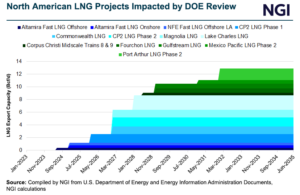M&A | E&P | NGI All News Access | NGI The Weekly Gas Market Report
ExxonMobil Says Adios to Barnett in $750M Deal with Denver’s BKV
© 2024 Natural Gas Intelligence. All rights reserved.
ISSN © 2577-9877 | ISSN © 1532-1266 | ISSN © 2158-8023 |

Regulatory
While regulatory uncertainty from the Department of Energy (DOE) hangs over U.S. LNG development, former FERC Chairman Neil Chatterjee sees the pathway for permitting at the Commission improving. The liquefied natural gas industry’s focus has largely been pulled to the DOE since January, when the Biden administration ordered the agency to study the impact of…
May 8, 2024By submitting my information, I agree to the Privacy Policy, Terms of Service and to receive offers and promotions from NGI.